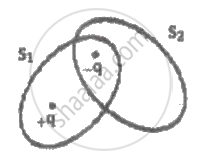Advertisements
Advertisements
प्रश्न
Draw equipotential surfaces:
(1) in the case of a single point charge and
(2) in a constant electric field in Z-direction. Why are the equipotential surfaces about a single charge not equidistant?
(3) Can electric field exist tangential to an equipotential surface? Give reason
उत्तर
(1)

(2)

The equipotential surfaces about a single charge are not equidistant because electric field due to a single change is not constant.
(3) If the electric field exist along tangential to an equipotential surface, a charged particle will experience a force along the tangential line and can move along it. As a charged particle can move only due to the potential difference (along with the direction of change of potential), this contradicts the concept of an equipotential surface.
APPEARS IN
संबंधित प्रश्न
Define an equipotential surface.
Draw a sketch of equipotential surfaces due to a single charge (-q), depicting the electric field lines due to the charge
The top of the atmosphere is at about 400 kV with respect to the surface of the earth, corresponding to an electric field that decreases with altitude. Near the surface of the earth, the field is about 100 Vm−1. Why then do we not get an electric shock as we step out of our house into the open? (Assume the house to be a steel cage so there is no field inside!)
Draw the equipotential surfaces due to an electric dipole. Locate the points where the potential due to the dipole is zero.
Statement - 1: For practical purpose, the earth is used as a reference at zero potential in electrical circuits.
Statement - 2: The electrical potential of a sphere of radius R with charge Q uniformly distributed on the surface is given by `Q/(4piepsilon_0R)`.
S1 and S2 are the two imaginary surfaces enclosing the charges +q and -q as shown. The electric flux through S1 and S2 are respectively ______.

Assertion: Electric field is discontinuous across the surface of a spherical charged shell.
Reason: Electric potential is continuous across the surface of a spherical charged shell.
Consider the following statements and select the correct statement(s).
- Electric field lines are always perpendicular to equipotential surface.
- No two equipotential surfaces can intersect each other.
- Electric field lines are in the direction of tangent to an equipotential surface.
Draw equipotential surfaces for (i) an electric dipole and (ii) two identical positive charges placed near each other.
What is meant by an equipotential surface?
